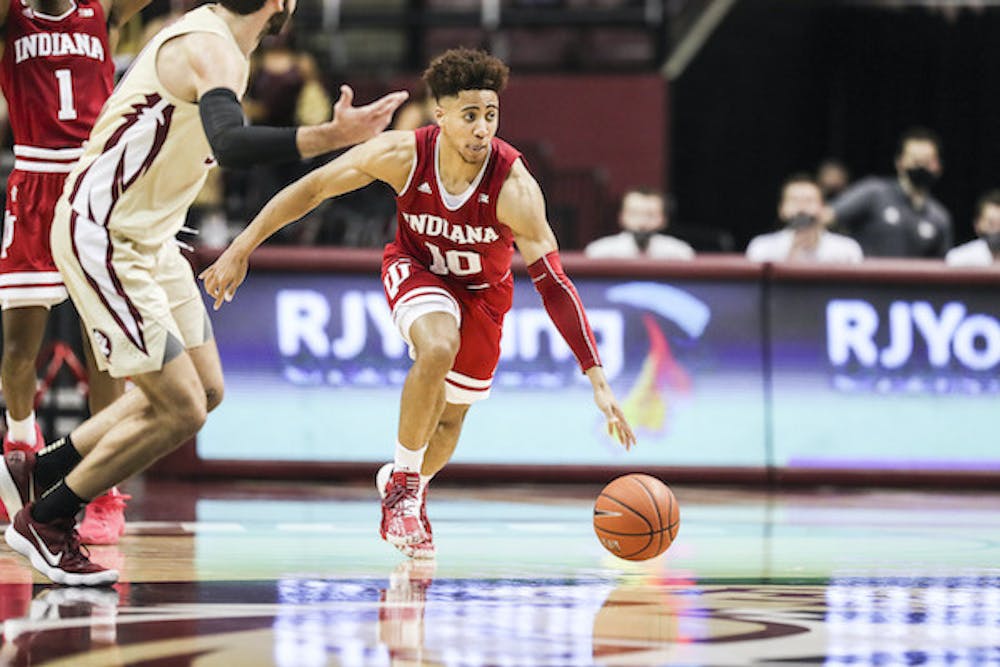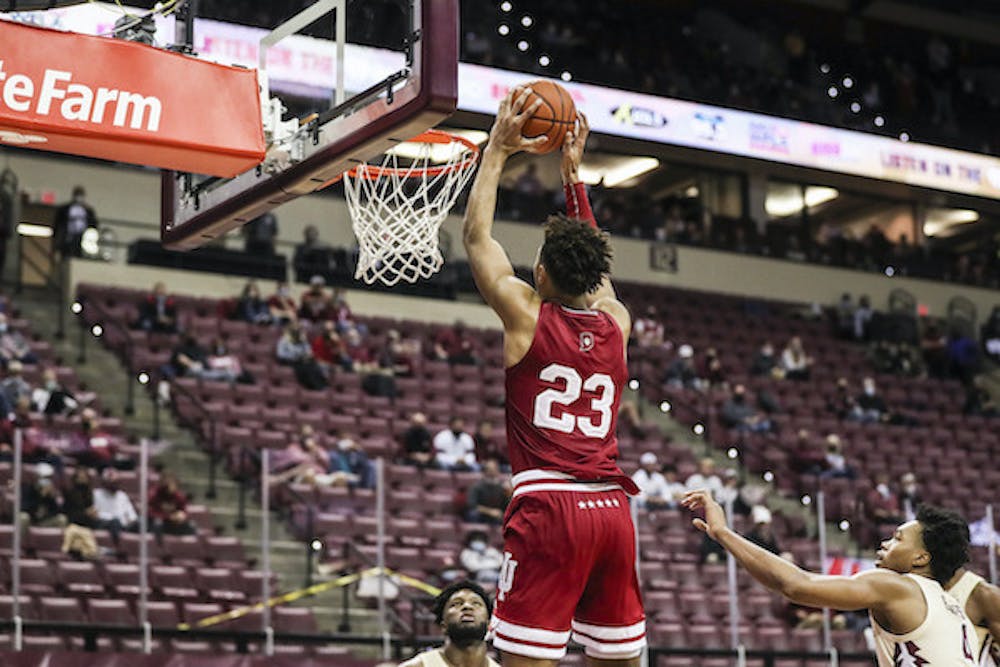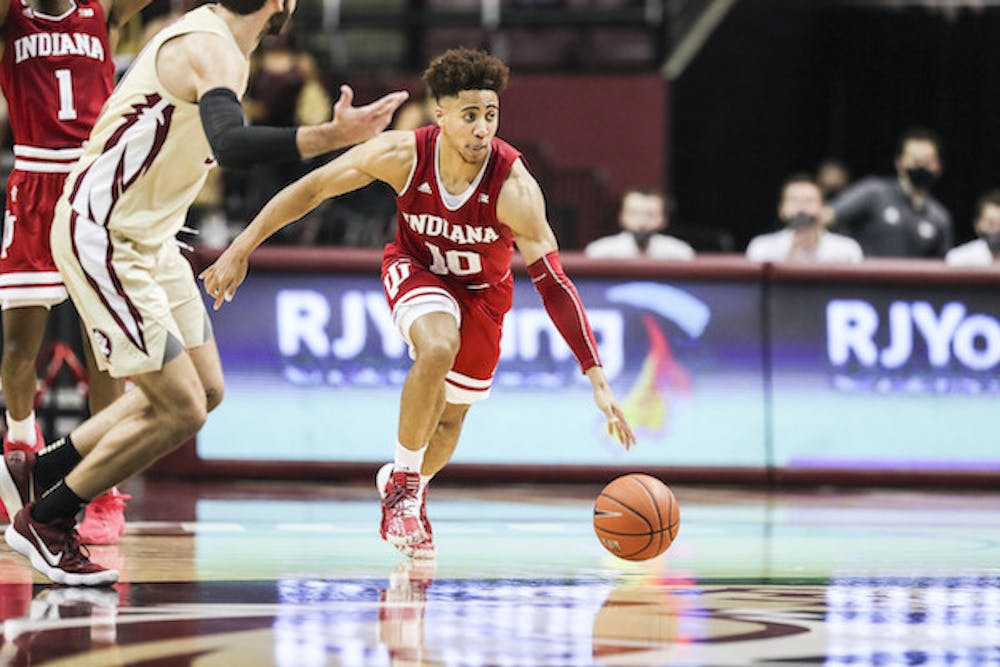After Indiana dominated Florida State a year ago in Bloomington, the Seminoles got revenge over the Hoosiers in the ACC/Big Ten Challenge on Wednesday in Tallahassee during the final seconds.
Florida State freshman Scottie Barnes banked in a tightly contested, close-range floater with 1.8 seconds left to put the Seminoles ahead and ultimately beat the Hoosiers 69-67 in overtime.

Despite playing tough with a nationally ranked opponent on the road, the game will ultimately be big a missed opportunity for Indiana’s resume come March and drops Indiana to 3-2 on the season.
Indiana head coach Archie Miller was vocal about how much the loss hurt for his team.
“That locker room was vastly different than a lot of locker rooms I’ve been in here,” Miller said. “That was a very, very upset team.”
The contest was truly a back-and-forth ordeal the entire way. Through the entire second half and overtime period, neither team had a lead larger than four points.
Although Indiana came close, and coming close isn’t enough to win, there were plenty of positives to take away.
Overcoming adversity
Before the game, there was plenty of question of how shorthanded Indiana without 6-foot-11 center Joey Brunk would handle the overwhelming size of Florida State.
Indiana only had two players available who were 6-foot-8 or taller in Trayce Jackson-Davis and Race Thompson. The Seminoles on the other hand had eight players at that height or bigger.
A differential in height and athleticism punished Indiana and its offense last week in Maui as the team had one of its worst offensive performances in the past decade, losing to a similarly structured roster in No. 14 Texas, 66-44.
This time around, Indiana handled the size difference well and was able to score the ball much better than it did against Texas.
“I thought we played with confidence on offense,” Miller said. “Our offense for the most part was able to function and get some quality shots.”
They did not shoot the ball phenomenally well, only 36.8% from the field and a measly 26.7% from 3-point range, but those figures were enough to be in the game with how Indiana handled Florida State defensively.
For having such a huge size advantage, the Seminoles only scored 32 of their points in the paint and overall shot 32.6% from the field. Additionally, the two teams tied in rebounding, each finishing with 44 boards for the game.
Beyond any statistic, Indiana had a strong response to Florida State’s fast start. The Seminoles opened the game on an 8-2 run and forced the Hoosiers to call timeout just a minute and 27 seconds in.
Unlike the Texas game, where as soon as the Longhorns got going Indiana was done for, the Hoosiers responded nicely, going an 8-0 run of their own to follow and fought all night.
Trayce Jackson-Davis’ Stardom
It’s become a typical night when Jackson-Davis absolutely dominates for Indiana and that was no different tonight.

The sophomore forward finished with 25 points on 8-for-15 shooting with 17 rebounds.
“He’s showing right now that he’s one of the best players in college basketball,” Miller said of his star player.
What made the effort more impressive was how Florida State consistently put double teams and a hoard of big bodies around Jackson-Davis to clog the paint, but he still finished well.
Florida State’s sophomore center Balsa Koprivica had primary responsibility of guarding Jackson-Davis in his 21 minutes. The 7-foot-1 center could not handle him defensively, though, as he was consistently in foul trouble and ended up fouling out.
Moving forward
While the positives were there and were far better than the aftermath in the first loss against Texas, Indiana still has much to improve with one particular area of focus.
Even with tying Florida State on the boards, the Hoosiers allowed Florida State to have 19 offensive rebounds and numerous second-chance opportunities.
“I don’t feel good about rebounding,” Miller said. “For me and my staff it’s our No. 1 concern.”
In addition to the rebounding, Indiana will have to learn how to close and execute in tight games down the stretch.
This was their first game of the year that came down to the wire, but winning these games distinguishes the good teams from the great. With the high expectations that this team has, winning tight games will be necessary to reach their goals.
Close games against difficult opponents will likely be a common theme with the strength of the Big Ten once again this year.
Jackson-Davis shared that sentiment, and echoed the team’s goals and frustration after the close loss.
“When I got in the locker room, I was angry, I was really mad,” Jackson-Davis said. “I don’t think of us as any other IU team that we’ve had in the last 10 years. I’m trying to be different this year, and to be different you’ve got to win these games.”






